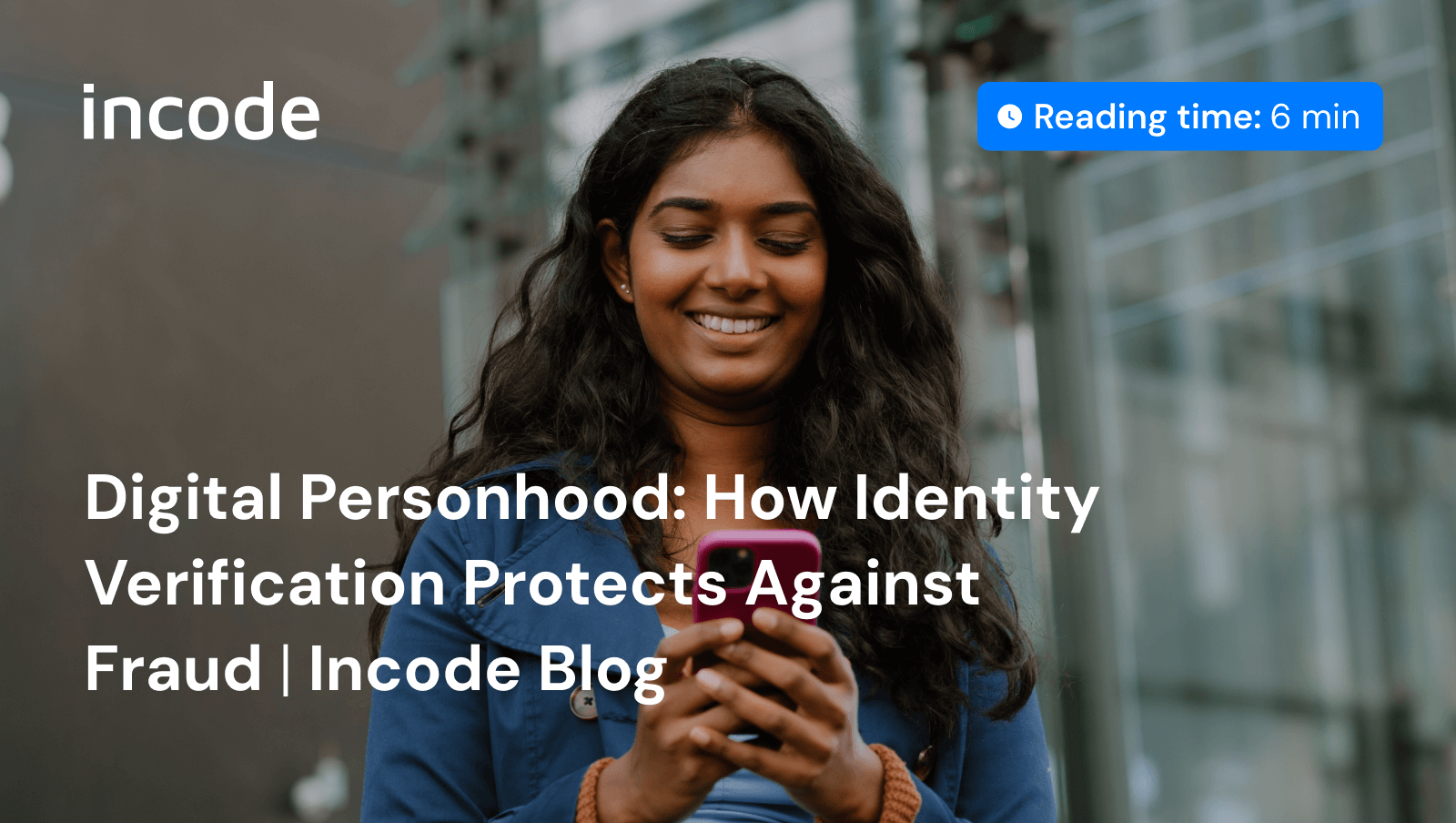Digital Personhood: How Identity Verification Protects Against Fraud | Blog
We often think of identity verification as a set of systems and security measures that confirm that a user attempting to make a transaction or use of a digital service is genuine. But the concept of digital personhood extends beyond these simple terms. Below we will discuss some of the implications of personhood and how identity verification paves the way for a more inclusive and secure world.
Traditional Identity Verification
What makes us unique individuals? Understanding personhood reminds us that a person is not limited to the set of information we might find on an ID. You and I, our essence, is not limited to our name, date of birth or nationality. Nor is it that my last name is different from yours, or the particular configuration of our social security number.
In addition, traditionally, the way to prove our identity fell to some state entity, or other centralized organization. These systems have different limitations, but perhaps the most important are:
- They don’t have different layers of information. For example, when visiting another country, the border agent cannot tell what my occupation is just by looking at my passport.
- They are vulnerable to various security attacks. In a traditional identity verification system, a database breach is enough to steal an individual’s identity.

Redefining Personhood in the Digital Age
More sophisticated identity verification, which overcomes security challenges and does not limit individuals, must focus on a new vision of personhood. As the thinker and sociologist Georg Simmel points out:
- Personhood is unique. Each individual is the sum of all his features, his knowledge, the places he has been, and so on. No two people have the same set of features and interactions with other individuals.
- Personhood is social. No person exists apart from the social aspect. In the universe of identity verification, this is relevant for certain spheres, for example, when a company wants to know what a candidate’s previous work relationships have been.
- Personhood is intersectional. People share features with others at different levels, for example in families, in geographic areas, etc.
Now, think of complex identity verification systems, which do more than just check a person’s name. In such a system, a person can protect their privacy without revealing too much information, if certain factors that give their unique characteristics are considered. Or a person can gain credibility and trust by showing that his or her identity has been previously verified. This protects security and encourages inclusion.
The Dangers of not Considering Personhood
In our hyper-technologized world, identity verification is becoming more and more related to personhood. When we confirm a person’s identity, we must ensure that there is actually a live human being interacting with a service or application on the other side of the screen. Now more than ever, it’s not just about protecting data and privacy, but about securing digital rights that defend against identity theft and manipulation and fraud.
As technology advances, so do the methods used by fraudsters: from simple digital manipulation of identity documents to sophisticated deepfakes generated with artificial intelligence. The rise of deepfake technology means fraudsters can now generate highly realistic, AI-driven images or videos that can easily deceive unprepared verification systems.
These security risks have serious implications for businesses across multiple industries, from banking and fintech to healthcare, e-commerce, insurance, and more. Without robust liveness detection, the integrity of user interactions, critical financial transactions, and sensitive personal data is at risk.
Therefore, liveness detection methods focus on a simple but crucial aspect: is it a live person, and is that person whom he or she claims to be? The liveness test considers various factors, such as biometrical cues, facial features, involuntary movements, and ther behavioral patterns.

Incode’s Liveness and Personhood Solutions: Fast, Secure, and User-Friendly
In the evolving world of identity verification, Incode’s Liveness Detection technology sets a new standard by integrating digital, physical, and evasion spoof detection. This multifaceted approach doubles the effectiveness of traditional methods, which typically depend on analyzing multiple frames of a 2D image. Such methods often falter under the challenge of sophisticated spoofing attempts, affecting both user experience and security.
In contrast, Incode Liveness Detection enhances identification accuracy by selecting the most effective frames and incorporating a combination of video, depth, and motion sensors. This not only mimics real-life interactions but also drastically reduces both false positives and negatives, ensuring a reliable and seamless verification process. With Incode, users experience enhanced security that’s both efficient and user-friendly.
Key Features of Incode’s Liveness Solution
- Advanced AI Models: The system leverages proprietary machine learning models that detect physical and digital spoofing attacks with high accuracy. It can identify even subtle signs of spoofing, like involuntary facial movements, that indicate a real person is being captured.
- Comprehensive Fraud Detection: The system uses three layers of defense—physical spoof detection, evasion detection, and digital spoof detection—to guard against sophisticated attacks such as deepfakes. This ensures fewer false positives and negatives, improving the overall security of identity verification.
- Vast Data Training: Incode’s models are trained on a dataset of over 1 million fraud attempts, collected over 10 years. This extensive, diverse dataset ensures unbiased results across different demographics—ensuring reliability regardless of age, skin tone, or gender.
- Multimodal Video Liveness: Our advanced response to Active Liveness aims to eliminate false positives completely while maintaining low false negatives. Traditional single-frame RGB methods, though quick and accurate, can miss attacks obvious to the human eye due to their reliance on limited data. By integrating a temporal dimension and multiple modalities, we significantly enhance our ability to detect both physical and digital spoofs, achieving dramatically higher accuracy.
How Does Incode’s Liveness Detection Work?
- Physical Spoof Detection: Identifies common physical spoofs such as photos, videos, or masks.
- Digital Spoof Detection: Detects deepfakes and AI-generated faces by analyzing subtle digital cues.
- Evasion Detection: Recognizes attempts to alter facial features using makeup, extreme expressions, or other modifications.
These checks are completed with unmatched speed and security without compromising the user experience.
Key Benefits from Incode’s Liveness Solution
- Reduced Drop-Off Rates: Since passive liveness requires no active user participation, it results in fewer onboarding interruptions and significantly fewer user drop-offs compared to active liveness methods.
- Enhanced Security: Incode’s technology has a 99.7% success rate in preventing sophisticated digital attacks, such as deepfakes, and in detecting presentation attacks.
- Cross-Industry Applications: Incode’s liveness solution works across various industries—from banking to gaming—offering secure and quick identity verification for account creation, transactions, and customer authentication.
Addressing the Shortcomings of Traditional Systems
Incode’s approach also tackles the limitations of centralized and individualistic identity systems. Centralized systems create single points of failure, while individualistic models often lack coherence. Incode’s system relies on a distributed and multi-layered framework for identity verification, ensuring that no one entity can monopolize control over users’ personal information. This decentralized approach mirrors real-world social relationships, providing added security and minimizing the risk of authoritarian control.
By combining passive liveness, cutting-edge AI models, and a robust fraud detection system, Incode is leading the way in creating a safer, more trustworthy digital world. Its focus on personhood ensures that individuals’ digital rights are protected, laying the groundwork for a more secure digital democracy.
